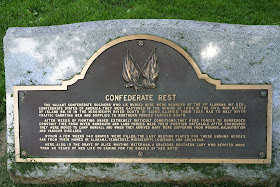The dictionary defines hallowed as something regarded as holy; venerated; sacred. On our recent road trip we saw three places that are definitely hallowed ground.
Island No.10 is in the Mississippi River, just south of Cairo, Illinois. It was held by the Confederacy until the spring of 1862, when it was attacked and put under siege. After a protracted struggle, the Confederate troops realized they were in an untenable position and surrendered. The captives were sent to Camp Randall in Madison, Wisconsin. They were generally in poor condition; many were wounded and diseased. Some 140 graves were soon filled, and thus the most northern Confederate cemetery came into being. Their graves were lovingly tended for over 30 years by a gracious Southern lady, Alice Whiting Waterman. Next to the Confederate graves is a group of graves of Northern soldiers who died in the vicinity of Camp Randall.


Above is the Confederate Section of the cemetery and a couple of graves with flowers.
Below is the Union section.

The Battle of the Little Bighorn occurred on June 25 and June 26, 1876 along and just north of the Litle Bighorn river in southwestern Montana. It was a battle between the US 7th Cavalry led by Lt. Col George Armstrong Custer and the Lakota Sioux, Cheyenne and Arapaho Native Americans. This battle and battleground is one of the most studied in the world. 268 US soldiers and scouts were killed, including Custer, and another 55 wounded. The number of Native American casualties is not known.
Below is a view of the battlefield from just below the hill where Custer and the troops that were immediately around him died. At the bottom of the hills in the trees is the Little Bighorn River, where the Native American encampment was.
The next photo was taken from the same place as the first, the photographer turning 90 degrees to the left(east). The monument is to the men of the 7th Cavalry and is on the spot Custer's body was found. The gravestones in the fence below the hill are for the men that died near Custer, with the attempt made to place the markers where their bodies were found.


The photos below look southwest across the graves near the top of the hill to the Little Bighorn in the trees at the bottom of the hills.


The photo below shows the Native American Memorial just north of the Custer memorial.

The photo below was taken from the bluffs just above the Little Bighorn. Major Reno and Captain Benteen established defensive positions on these bluffs and managed to survive with some of their troops.

This photo is on the east part of the battlefield with markers placed where soldiers died.

Standing on the battlefield one gets the feeling of great tragedy for all involved and for our nation as a whole. Hallowed ground.
In May of 1856 a group of Mormon converts, known as the Willie company, sailed from England to the United States. Their ultimate destination was Salt Lake City. They traveled to Iowa and Florence, Nebraska where they put their belongings and provisions in hand carts and began the trek west. By now it was August, and although warned they were too late and should winter over in Iowa or Nebraska they decided to go on to Utah. There were about 400 people who left Florence, Nebraska on August 17. They had a number of problems: the handcarts were made from green wood and broke down; their cattle got mixed up with a buffalo herd and 30 of them were killed; they thought they were to be resupplied at Fort Laramie but there were no provisions for them at the Fort. They ran out of provisions about October 17 , near the sixth crossing of the Sweetwater River in Wyoming. A blizzard struck at the same time with winds, heavy snow and freezing temperatures. A rescue party sent from Salt Lake City found them on 21 October. Eight people died and were buried at the sixth crossing. The night of the rescue they held a meeting and voted unanimously to send half the rescue party on to find the Martin company which was about 70 miles behind them. That selfless act resulted in the death of another 12 people as they fought their way up Rocky Ridge and down to Rock Creek Hollow.
The photos below show the Oregon-Mormon trail leading to the sixth crossing of the Sweetwater, which is hidden by the trees. The Bureau of Land Management, who has control of this land, says that this area is unchanged since 1856. An awful place to be trapped in a blizzard. Frozen ground, snow, wind and no cover.


The campsite at the sixth crossing is marked by a monument to one of the pioneers who died there, John Linford. It is in the middle of the trail, about one-half mile from the river itself. I know of no ground more hallowed than this.


















